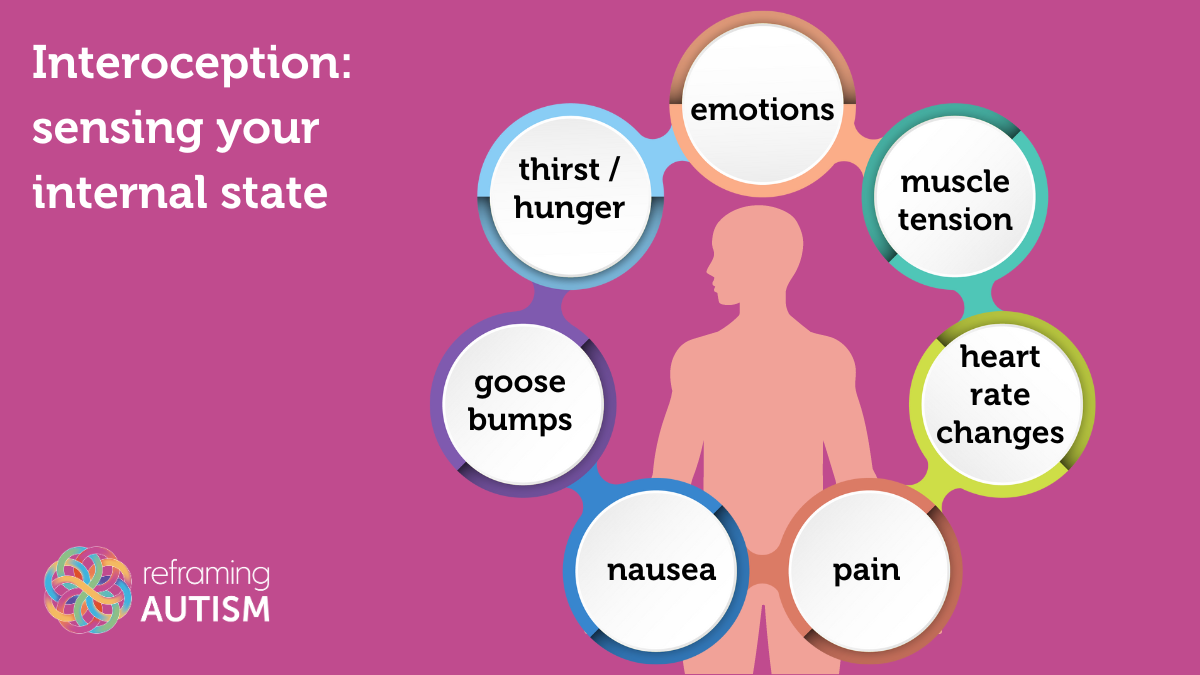
If the answer is yes, you may, like many Autistic individuals, experience interoception differences.
Interoception is colloquially known as the eighth sense (Mahler, 2017), and is a lesser-known yet crucial sense that helps individuals perceive and interpret signals originating from within their own bodies – signals such as hunger pains, thirst, fatigue, nausea, tummy flutters, a racing heart, goosebumps, sexual arousal, muscle tension, toileting urges, and even pain.
Our interoceptive awareness is mediated by a network of sensory receptors located in various organs, including the heart, lungs, stomach, bladder, eyes and skin. These receptors send signals to the insula in our brain about the state of our body’s internal environment. Our brain then uses the information about how our body feels as clues to our emotional state. Are we anxious, sick, tired or excited?
Interoception is important because we need to be able to sense, process and integrate our bodily cues in order to maintain homeostasis, regulate our emotions and enjoy an overall state of wellbeing and connection to ourselves and others.
Research shows our Autistic community experiences interoception differences more frequently than non-autistic individuals (Zachary et al., 2023). Similar to our sensory processing of external stimuli, Autistic individuals may be hyper- (over) or hypo- (under) aware of our bodies’ internal cues.
This means we might have difficulty accurately perceiving our internal body signals, we may over-feel these signals or simply have difficulty differentiating between body signals and emotional signals, for example, struggling to discern if our discomfort is due to hunger or anxiety.
Such challenges can manifest in various ways and significantly impact our daily life, and physical and emotional wellbeing.
Interoception differences can make it difficult for Autistic individuals to accurately recognise and respond to basic bodily needs. This can lead to irregular eating and drinking habits, dehydration, constipation, or difficulty getting to the bathroom in time.
When non-autistic individuals begin to feel frustrated, angry, or upset, they can recognise these emotions and can utilise internal bodily signals to help them understand the reasons for those emotions, to take action to address them. In contrast, some Autistic people might struggle to notice and connect internal physical sensations with emotions. This confusion and disconnect can make it challenging to actively regulate our emotions when we need to do so.
As a result, we might appear fine, until unmet physical and emotional needs pile up and overwhelm us, leading to big emotions and/or survival behaviours like meltdown or shutdown.
Read more about how Autistic people experience emotions differently.
Interoception is essential for introspection, the ability to reflect on one’s thoughts and feelings. Autistic individuals with interoception differences might find it challenging to engage in introspection, as it can prove difficult to interpret internal cues and connect them with our mental and emotional states. This can affect our ability to understand ourselves and integrate our experiences.
Many Autistic individuals are also alexithymic. alexithymia is a condition in which a person has difficulty identifying and describing their emotions and is closely associated with interoception differences. When internal bodily signals are misinterpreted or not recognised, it becomes challenging to associate these signals with specific emotions and identify how you’re feeling. This can lead to a confused sense of self. Read an Autistic account of alexithymia.
Some Autistic individuals may experience heightened sensitivity to internal signals of pain. This can make it look like we’re being ‘overly dramatic’ with big reactions, but it is vital to remember that each person’s experience of their pain is genuine, individual, and intimately related to their interoceptive sensitivity. Others might have a diminished sensitivity, making it harder to notice when they’re in pain.
This can have long-term health implications as Autistic people with low pain interoception may not attend to symptoms of injury, disease, illness or infection in themselves until it is well advanced. Read more about the Autistic experience of pain.
Social interactions often rely on the ability to recognise and respond to one’s own as well as others’ emotional states. Interoception differences can make it harder for Autistic individuals to pick up on social cues and respond appropriately. For instance, we might not notice subtle signs of discomfort or stress in ourselves, which would help us remove ourselves from overwhelming or even dangerous situations.
Atypical interoception can also affect overall health and wellbeing. Difficulty in recognising and responding to bodily needs can lead to chronic health issues, such as poor nutrition, dehydration, and gastrointestinal problems. Additionally, the stress associated with misinterpreting internal signals can contribute to mental health challenges, such as anxiety and depression.

Autistic-led research shows that our interoception can be improved and there are many activities that can be harnessed to improve your or a loved one’s interoception (Goodall, 2021).
Here are some strategies that can help:
Interoceptive awareness training involves activities and exercises designed to help individuals recognise and interpret internal signals. Mindfulness practices, body scans, and guided relaxation techniques can be beneficial. These practices can enhance awareness of bodily sensations and improve the ability to connect these sensations with emotions and needs.
Visual supports, such as emotion charts and body maps, can aid Autistic individuals in identifying and expressing their internal states. These tools provide a visual representation of bodily sensations and emotions, making it easier to communicate needs and feelings. For example, an emotion chart might help an individual identify that a headache is related to stress or that a stomachache signals hunger.
Establishing consistent routines around eating, drinking, and other selfcare activities can help mitigate the challenges of interoception differences. Regular schedules can serve as external reminders to address internal needs, reducing reliance on internal signals that might be misinterpreted or unnoticed.
Creating a supportive and predictable environment can help Autistic individuals manage interoceptive challenges. Reducing sensory overload and embracing technology such as phone alerts to prompt selfcare activities such as drinking water can help individuals feel more in control of their internal states.
In a 2019 study, Autistic researchers found that repetitive, stimming behaviours, such as hand flapping and body rocking, are self-soothing and help to regulate the autonomic nervous system, which in turn generates interoceptive signals (Palser et. al., 2020). The focused attention from such stimming behaviours helped the Autistic children to accurately notice their heartbeats.
Caregivers, educators, family members and healthcare professionals should advocate for accommodations and encourage self-regulatory behaviours such as stimming, to provide a supportive environment for the Autistic individual.
Read more about the study in our summary for non-academics.
Supporting Autistic individuals with interoception differences requires a deep understanding and acceptance of our unique experiences. It’s important to recognise that our perception of our own bodies may differ significantly from non-autistics, yet this difference is not a deficit. Our responses to internal cues, and physical sensations may be unexpected to some, but these responses are our authentic lived reality.
Validating and respecting our experiences, even when they diverge from neuronormative expectations, fosters an environment of support and empathy. By acknowledging and embracing these differences, loved ones can provide meaningful and compassionate support to us.
Informing caregivers, educators, family members and healthcare professionals about interoception and its impact on Autistic individuals is crucial. Interoception differences significantly affect various aspects of life for Autistic individuals, from recognising basic bodily needs to managing emotions and engaging in social interactions. By understanding these impacts and implementing supportive strategies, we can improve Autistic quality of life, and support greater selfcare, emotional wellbeing, and social connection.
Goodall, E., (2021). Facilitating Interoceptive Awareness as a Self-Management and Self-Regulation Tool to Increase Engagement in Learning and Education. Master’s Thesis, University of Southern Queensland.
Mahler, K., (2017). Interoception: The eighth sensory system. Lexena: AAPC Publishing.
Palser, E.R., Fotopoulou, A., Pellicano, E. et al. (2020). Dissociation in How Core Autism Features Relate to Interoceptive Dimensions: Evidence from Cardiac Awareness in Children. J Autism Dev Disord 50, 572–582. https://doi.org/10.1007/s10803-019-04279-4
Williams, Z.J., Suzman, E., Bordman, S.L. et al. (2023). Characterizing Interoceptive Differences in Autism: A Systematic Review and Meta-analysis of Case–control Studies. J Autism Dev Disord 53, 947–962. https://doi.org/10.1007/s10803-022-05656-2

The Reframing Autism team would like to acknowledge the Traditional Owners of the lands on which we have the privilege to learn, work, and grow. Whilst we gather on many different parts of this Country, the RA team walk on the land of the Awabakal, Birpai, Whadjak, and Wiradjuri peoples.
We are committed to honouring the rich culture of the Aboriginal and Torres Strait Islander peoples of this Country, and the diversity and learning opportunities with which they provide us. We extend our gratitude and respect to all Aboriginal and Torres Strait Islander peoples, and to all Elders past and present, for their wisdom, their resilience, and for helping this Country to heal.